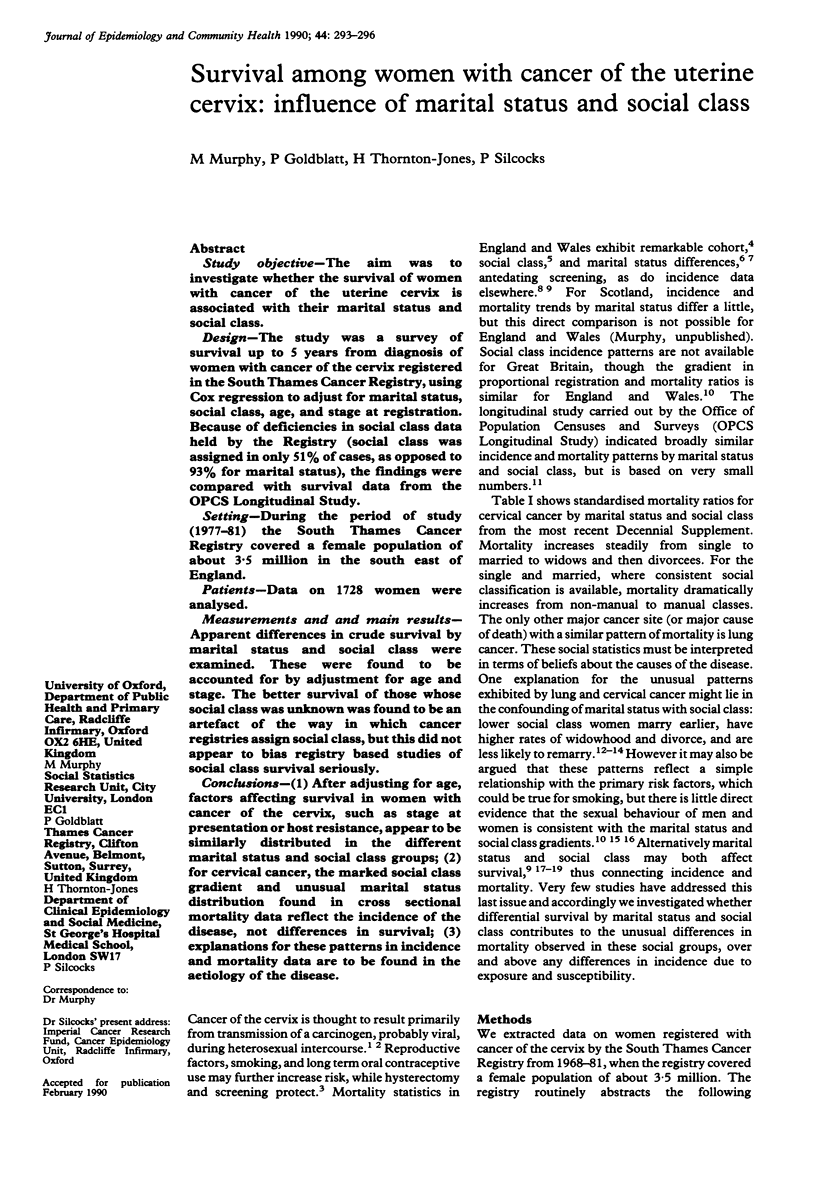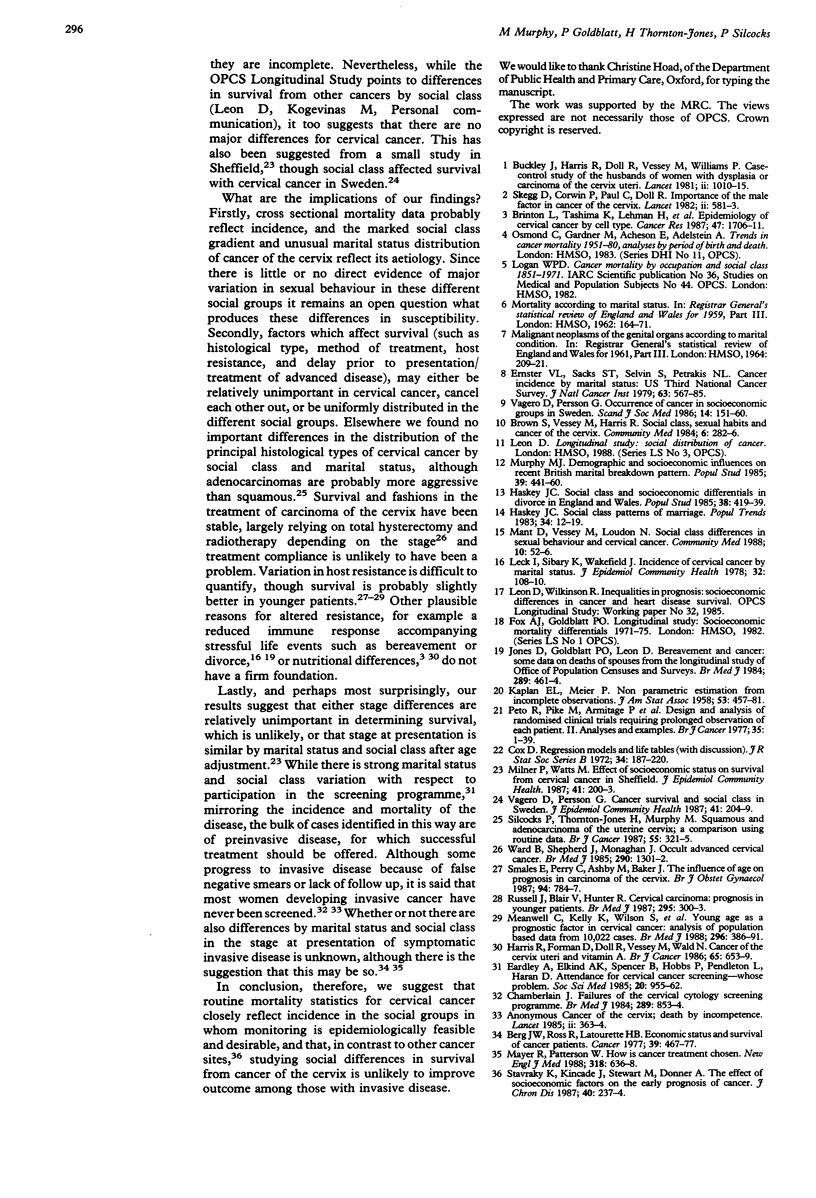Abstract
STUDY OBJECTIVE--The aim was to investigate whether the survival of women with cancer of the uterine cervix is associated with their marital status and social class. DESIGN--The study was a survey of survival up to 5 years from diagnosis of women with cancer of the cervix registered in the South Thames Cancer Registry, using Cox regression to adjust for marital status, social class, age, and stage at registration. Because of deficiencies in social class data held by the Registry (social class was assigned in only 51% of cases, as opposed to 93% for marital status), the findings were compared with survival data from the OPCS Longitudinal Study. SETTING--During the period of study (1977-81) the South Thames Cancer Registry covered a female population of about 3.5 million in the south east of England. PATIENTS--Data on 1728 women were analysed. MEASUREMENTS AND AND MAIN RESULTS--Apparent differences in crude survival by marital status and social class were examined. These were found to be accounted for by adjustment for age and stage. The better survival of those whose social class was unknown was found to be an artefact of the way in which cancer registries assign social class, but this did not appear to bias registry based studies of social class survival seriously. CONCLUSIONS--(1) After adjusting for age, factors affecting survival in women with cancer of the cervix, such as stage at presentation or host resistance, appear to be similarly distributed in the different marital status and social class groups; (2) for cervical cancer, the marked social class gradient and unusual marital status distribution found in cross sectional mortality data reflect the incidence of the disease, not differences in survival; (3) explanations for these patterns in incidence and mortality data are to be found in the aetiology of the disease.
Full text
PDF



Selected References
These references are in PubMed. This may not be the complete list of references from this article.
- Berg J. W., Ross R., Latourette H. B. Economic status and survival of cancer patients. Cancer. 1977 Feb;39(2):467–477. doi: 10.1002/1097-0142(197702)39:2<467::aid-cncr2820390215>3.0.co;2-b. [DOI] [PubMed] [Google Scholar]
- Brinton L. A., Tashima K. T., Lehman H. F., Levine R. S., Mallin K., Savitz D. A., Stolley P. D., Fraumeni J. F., Jr Epidemiology of cervical cancer by cell type. Cancer Res. 1987 Mar 15;47(6):1706–1711. [PubMed] [Google Scholar]
- Buckley J. D., Harris R. W., Doll R., Vessey M. P., Williams P. T. Case-control study of the husbands of women with dysplasia or carcinoma of the cervix uteri. Lancet. 1981 Nov 7;2(8254):1010–1015. doi: 10.1016/s0140-6736(81)91215-0. [DOI] [PubMed] [Google Scholar]
- Chamberlain J. Failures of the cervical cytology screening programme. Br Med J (Clin Res Ed) 1984 Oct 6;289(6449):853–854. doi: 10.1136/bmj.289.6449.853. [DOI] [PMC free article] [PubMed] [Google Scholar]
- Eardley A., Elkind A. K., Spencer B., Hobbs P., Pendleton L. L., Haran D. Attendance for cervical screening--whose problem? Soc Sci Med. 1985;20(9):955–962. doi: 10.1016/0277-9536(85)90352-1. [DOI] [PubMed] [Google Scholar]
- Ernster V. L., Sacks S. T., Selvin S., Petrakis N. L. Cancer incidence by marital status: U.S. Third National Cancer Survey. J Natl Cancer Inst. 1979 Sep;63(3):567–585. doi: 10.1093/jnci/63.3.567. [DOI] [PubMed] [Google Scholar]
- Harris R. W., Forman D., Doll R., Vessey M. P., Wald N. J. Cancer of the cervix uteri and vitamin A. Br J Cancer. 1986 May;53(5):653–659. doi: 10.1038/bjc.1986.109. [DOI] [PMC free article] [PubMed] [Google Scholar]
- Jones D. R., Goldblatt P. O., Leon D. A. Bereavement and cancer: some data on deaths of spouses from the longitudinal study of Office of Population Censuses and Surveys. Br Med J (Clin Res Ed) 1984 Aug 25;289(6443):461–464. doi: 10.1136/bmj.289.6443.461. [DOI] [PMC free article] [PubMed] [Google Scholar]
- Leck I., Sibary K., Wakefield J. Incidence of cervical cancer by marital status. J Epidemiol Community Health. 1978 Jun;32(2):108–110. doi: 10.1136/jech.32.2.108. [DOI] [PMC free article] [PubMed] [Google Scholar]
- Mant D., Vessey M., Loudon N. Social class differences in sexual behaviour and cervical cancer. Community Med. 1988 Feb;10(1):52–56. doi: 10.1093/oxfordjournals.pubmed.a042379. [DOI] [PubMed] [Google Scholar]
- Mayer R. J., Patterson W. B. How is cancer treatment chosen? N Engl J Med. 1988 Mar 10;318(10):636–638. doi: 10.1056/NEJM198803103181011. [DOI] [PubMed] [Google Scholar]
- Meanwell C. A., Kelly K. A., Wilson S., Roginski C., Woodman C., Griffiths R., Blackledge G. Young age as a prognostic factor in cervical cancer: analysis of population based data from 10,022 cases. Br Med J (Clin Res Ed) 1988 Feb 6;296(6619):386–391. doi: 10.1136/bmj.296.6619.386. [DOI] [PMC free article] [PubMed] [Google Scholar]
- Milner P. C., Watts M. Effect of socioeconomic status on survival from cervical cancer in Sheffield. J Epidemiol Community Health. 1987 Sep;41(3):200–203. doi: 10.1136/jech.41.3.200. [DOI] [PMC free article] [PubMed] [Google Scholar]
- Peto R., Pike M. C., Armitage P., Breslow N. E., Cox D. R., Howard S. V., Mantel N., McPherson K., Peto J., Smith P. G. Design and analysis of randomized clinical trials requiring prolonged observation of each patient. II. analysis and examples. Br J Cancer. 1977 Jan;35(1):1–39. doi: 10.1038/bjc.1977.1. [DOI] [PMC free article] [PubMed] [Google Scholar]
- Russell J. M., Blair V., Hunter R. D. Cervical carcinoma: prognosis in younger patients. Br Med J (Clin Res Ed) 1987 Aug 1;295(6593):300–303. doi: 10.1136/bmj.295.6593.300. [DOI] [PMC free article] [PubMed] [Google Scholar]
- Silcocks P. B., Thornton-Jones H., Murphy M. Squamous and adenocarcinoma of the uterine cervix: a comparison using routine data. Br J Cancer. 1987 Mar;55(3):321–325. doi: 10.1038/bjc.1987.63. [DOI] [PMC free article] [PubMed] [Google Scholar]
- Skegg D. C., Corwin P. A., Paul C., Doll R. Importance of the male factor in cancer of the cervix. Lancet. 1982 Sep 11;2(8298):581–583. doi: 10.1016/s0140-6736(82)90661-4. [DOI] [PubMed] [Google Scholar]
- Smales E., Perry C. M., Ashby M. A., Baker J. W. The influence of age on prognosis in carcinoma of the cervix. Br J Obstet Gynaecol. 1987 Aug;94(8):784–787. doi: 10.1111/j.1471-0528.1987.tb03727.x. [DOI] [PubMed] [Google Scholar]
- Stavraky K. M., Kincade J. E., Stewart M. A., Donner A. P. The effect of socioeconomic factors on the early prognosis of cancer. J Chronic Dis. 1987;40(3):237–244. doi: 10.1016/0021-9681(87)90159-7. [DOI] [PubMed] [Google Scholar]
- Vågerö D., Persson G. Cancer survival and social class in Sweden. J Epidemiol Community Health. 1987 Sep;41(3):204–209. doi: 10.1136/jech.41.3.204. [DOI] [PMC free article] [PubMed] [Google Scholar]
- Vågerö D., Persson G. Occurrence of cancer in socioeconomic groups in Sweden. An analysis based on the Swedish Cancer Environment Registry. Scand J Soc Med. 1986;14(3):151–160. doi: 10.1177/140349488601400308. [DOI] [PubMed] [Google Scholar]
- Ward B. G., Shepherd J. H., Monaghan J. M. Occult advanced cervical cancer. Br Med J (Clin Res Ed) 1985 May 4;290(6478):1301–1302. doi: 10.1136/bmj.290.6478.1301. [DOI] [PMC free article] [PubMed] [Google Scholar]


